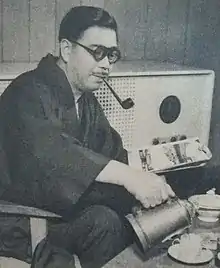Hideto Kishida
Hideto Kishida (6 February 1899 – 3 May 1966) was a renowned Japanese architect. His work was part of the architecture event in the art competition at the 1936 Summer Olympics.[1]
Hideto Kishida | |
|---|---|
 Hideto Kishida in 1951 | |
| Born | 6 February 1899 Fukuoka, Japan |
| Died | 3 May 1966 (aged 67) Yamanakako, Japan |
| Nationality | Japanese |
| Occupation | Architect |
Life
Kishida obtained a doctorate of engineering in 1929, and was later appointed as a professor at the University of Tokyo. Kishida was highly esteemed in the field of architectural design both before and during the post-war period.
After graduating from the Department of Architecture, which was part of the Faculty of Engineering at Tokyo Imperial University, he continued his tenure there as a lecturer. Among his notable designs over this period are the Tokyo Imperial University Auditorium (Yasuda Auditorium) and Faculty of Science Building No. 1 (now since demolished). Moreover, Kishida participated in reconstruction efforts for the damaged Imperial University campus.
His teachings had a great influence on pioneers in the field of architecture including Kenzo Tange, Kunio Maekawa, Michizo Tachihara, Ryuichi Hamaguchi, Takashi Asada, and many more, who were enrolled in the Kishida Laboratory.
References
- "Hideto Kishida". Olympedia. Retrieved 11 August 2020.